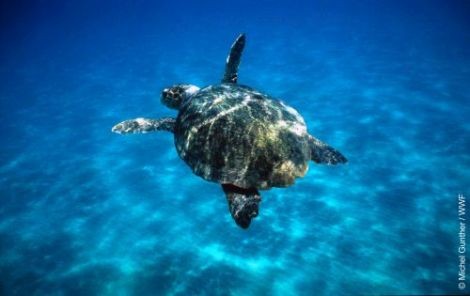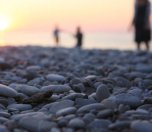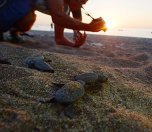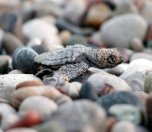Click to read the article in Turkish
The media covered the incident of caretta carettas’ biting five people at Orak Island near Bodrum with the headlines “Caretta Caretta terror,” and “Caretta carettas have attacked.”
Doğan News Agency (DHA) in its article reported the witnesses’ use of phrases like “I now fear getting into the sea”, “there are cardiac patients, there are those who can’t swim well, there are elderly people and children, measures have to be taken”.
Sea Turtles Research Save and Rehabilitation Center (DEKAMER) field manager Ahmet Yavuz Candan who criticizes people for feeding the loggerheads notes, “We will catch the caretta carettas, bring them to the center and will let them return to their natural habitat after rehabilitating them”.
So, is it caretta carettas or humans that require precautions to be taken against them? WWF-Turkey Conservation Supervisor Ayşe Oruç answered.
“It is normal that they get defensive”
“The sea turtles have been living in these waters for millions of years. Even though they are not aggressive, we must never forget that they are not pets. It is normal that they get defensive when they feel threatened.
“Feeding the turtles, making them a part of tourism, considering them pets are giving birth to this situation”.
“It is not an attack but self-defense”
“We have to be careful when we enter their home range. We must avoid getting closer to the turtles and feeding them, and we should not get close enough to put them under stress.
“What we have to do is ensure the protection of the natural habitats of animals and enable them to live without relying on people. We also have to mind the language we use when speaking about these incidents. There is no attempt of revenge, but rather self-defense.
“People shouldn’t feed the turtles”
“Those having their holidays near the nesting and feeding areas of the sea turtles, the people working at tourism sector such as tour boats, restaurants, diving club, shouldn’t allow the sea turtles to be fed.
“The sea turtles don’t disturb or bite people under normal circumstances”.
“It is under protection in the whole world”
“The caretta caretta species is one of the species that has become a symbol of natural protection works in our country.
“It is under protection by law in both our country and the world”.
“Tourists and turtles are at the same place at the same time”
“Not only caretta carettas but all sea turtles’ feeding and nesting areas, especially in Western and Central Mediterranean in Turkey, are open to tourism.
“The period of turtles of leaving their eggs on the sands is the end of May and beginning of August, which is the busy tourism season.
“The sea turtles and tourists use the same areas at the same time.
“We have to refrain ourselves from feeding the sea turtles with unnatural nutrition such as fish and chicken pieces”.
“Trying to catch, take picture, stroke them…”
“When tour boats anchor at the shores, many people getting into the sea, chasing the turtles to try to catch, take picture or stroke them may cause the animals to get stressed and become aggressive.
“Furthermore, the people who see an adult turtle and start kicking and hitting them in fear might lead them to bite for self-defense”.
“The only way is sustainable tourism”
“In this case, the tourists may prefer the businesses, (tour boat, diving club, etc.) which follow the rules.
“Protection of nesting and feeding areas of the turtles can only be realized by maintaining sustainable tourism in the area. We believe that this can only be achieved with the common efforts of the tourism sector workers and the visitors of those areas”. (EKN/TK)
Sea TurtleThe loggerhead sea turtle (Caretta caretta), or loggerhead, is an oceanic turtle distributed throughout the world. It is a marine reptile, belonging to the family Cheloniidae. The average loggerhead measures around 90 cm (35 in) long when fully grown, although larger specimens of up to 280 cm (110 in) have been discovered. The adult loggerhead sea turtle weighs approximately 135 kg (298 lb), with the largest specimens weighing in at more than 450 kg (1,000 lb). The loggerhead sea turtle is found in the Atlantic, Pacific, and Indian Oceans, as well as the Mediterranean Sea. It spends most of its life in saltwater and estuarine habitats, with females briefly coming ashore to lay eggs. The loggerhead sea turtle has a low reproductive rate; females lay an average of four egg clutches and then become quiescent, producing no eggs for two to three years. The loggerhead reaches sexual maturity within 17–33 years and has a lifespan of 47–67 years Nesting fields in Turkey: Ekincik, Dalyan, Dalaman, Fethiye (Muğla), Patara, Kale, Kumluca, Çıralı, Tekirova, Belek, Kızılot, Demirtaş, Gazipaşa (Antalya), Anamur, Göksu Deltası, Alata, Kazanlı, Davultepe (Mersin), Akyatan, Yumurtalık (Adana) and Samandağ (Hatay). Source: Wikipedia |












.jpg)


